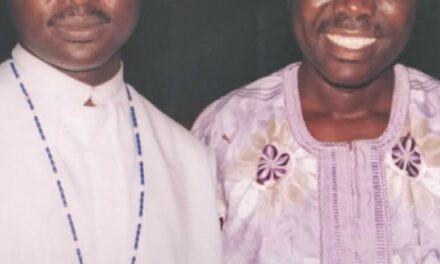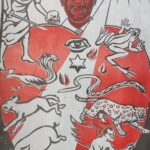I entered Adeyemi College of Education, Ondo, now Federal University of Education, Ondo in 1986 to study Fine Art and Education. Looking back, I would describe it as arriving “empty,” that is, knowing very little and open to any and all information, Art education, history, ideas, tools and techniques, and faculty. Everyday, every course, and every class meeting provided me and my course mates the resources, attitudes, and approaches to learning and growing that continue to benefit us in our different endeavours to this day. Faculty were our heroes and models as they inspired us and, yes, showed great restraint when as young men and women often did not get it.
Our dean, mentor and Art lecturer, Dr Emmanuel Olakunle Filani turns 65 years old on Thursday 8th September, 2022. As a milestone, reaching that age does not mean what was done before, but an opportunity to celebrate and appreciate Dr Filani. His work is worth seizing. Gifted and fearless, He remains an inspiration till date in all aspects of past and contemporary fine art practice, curatorial practice, art history and digital cultures. At Adeyemi College of Education, Dr Filani and others guided us towards the ever-becoming process of being better Christians, human beings, artists, and making a contribution to our field and to the world. Attending Dr Filani’s life drawing class or night painting is a reminder that art is 99% perspiration and 1% inspiration. As the course leader for my set, my leadership skills greatly improved under Dr Filani’s guidance and mentoring. I am immensely grateful to Dr Filani. His conceptualizations of what transcultural art history is and does have been deeply formative for me. Indeed, ‘a transcultural history of art goes beyond the principle of additive extension and looks instead at the transformatory processes that constitute art practice through cultural encounters and relationships, whose traces can be followed back to the beginnings of history.’ One is able to discover that ‘casting art history in a global/transcultural frame would involve questioning the taxonomies and values that have been built into the discipline since its inception and have been taken as universal.’[1] Dr Filani’s patience and oratory ability to systematically explain the problem of how units of investigation which exist next to each other and are connected through flows and transfers remains inspiring.
Through Dr Filani teaching, I appreciate the ‘critique of an additive approach to global art history rooted in the modern Western logic of representation.’ Dr Filani’s deep commitment to analytical and critical historiographic approaches of what constitutes art and its critical frameworks in a global framework not only provided us as his students ‘with discursive and analytical tools along with a vocabulary to articulate these ideas but also with the hope that a different art history beyond the institutionalized modern Western spatial and temporal structures will eventually become a reality.’
Dr Filani continue to help many personalities, institutions of art and art history to ‘become increasingly aware of their political and ethical responsibilities in relation to the role they play in shaping worldviews, subjects, citizens, and communities. Current global ecological, political, and social crises have once again underscored the urgency of unlearning universalized modern Western frameworks and the importance of studying our world’s cosmological, epistemological, and ontological heterogeneity that constitutes and is operative through manifold cultural and artistic articulations. In recent years, museums, art history departments, and art historical journals have begun to engage with their Eurocentric biases and difficult colonial histories, albeit in varying degrees and according to specific historical, social, political, and ideological contexts in different regions around the world.’
Dr Filani, aka – Baba Cool, we feel eternal gratitude for those years, especially for ‘the gift of being given the end of a ‘golden string’ – a living thread of love – that linked us into a vibrant and pure stream of perennial wisdom’ and artistic expressions. Socrates speaks of its study as a means to ‘purify the eye of the soul … whose conservation is more important than ten thousand fleshly eyes, since it is by that alone that we contemplate the truth.’ Dr Filani is always ready to remind us that, above and beyond the practical aspects of Fine Art and Art history lay its ‘higher purpose’ which aligns his golden teachings with God and some mighty forebears. Encyclopaedic yet eager to listen, Dr Filani remains one of the most natural sketchers I have ever met. His anatomy lessons still resonate when I manage to do figure paintings.
Dr Filani’s particular quality of teaching – ‘giving clues, opening doors, lifting the corner of a veil – so that for a moment you were transported to a completely new way of seeing, not only art but life itself and the universe as a whole.’ Dr Filani’s past and present students can attest to the fact that ‘each time you heard him, either in a lecture, or informal talk or a tutorial, the corner of that veil would be lifted a little higher and for a little longer.’
Dr. Filani, a quintessential academic with intellectual girth found expressions mainly in creative arts, art history, and the theory of aesthetics is also a consummate administrator as robustly demonstrated in many managerial posts he held over the years. Born on September 8, 1957, to the reputable FILANI dynasty of Ikole-Ekiti, Kunle Filani is a well-groomed gentleman with impeccable character. He obtained Bachelor’s degree in Fine Arts in 1980 from the then the University of Ife, now Obafemi Awolowo University, Ile-Ife. He proceeded to the University of Benin between 1982 and 1984 to study for a studio-based degree and obtained Master of Fine Arts (MFA) in Graphics with specialized in Printmaking.
He also went to the University of Lagos in 1995 and graduated with a Post Graduate Diploma in Education. Dr. Filani later obtained the Doctor of Philosophy degree (Ph.D.) from the Institute of African Studies, the University of Ibadan with a special interest in Visual Arts History. Dr Filani started his teaching career at the then Kano Teachers College during the NYSC days in 1980 to 1981. He had a brief teaching experience at St Louis College in Owo, Ondo State before going for further studies. He began his career as a Lecturer at the Adeyemi College of Education, Ondo, an affiliate of the University of Ife then in 1985.
He transferred his service to the Federal College of Education, (Technical) Akoka-Yaba, Lagos in April 1992. He remains in the College despite going on Leave of Absence to other institutions as an Administrator or during Sabbatical years. Filani’s administrative experience is huge and covers all possible opportunities available in the College system. At one time or the other, he was HOD, Dean, Deputy Provost, and Provost. All these came with heavy responsibilities and he demonstrated a breadth of capabilities and astute skills while in office.
As an academic with reputable contributions to scholarship, he researched and ventilated African Art with a special interest in Contemporary Nigerian Art and Yoruba artistic philosophies. As a vintage art historian, art critic, and explorer of aesthetic tendencies, Kunle Filani in many of his insightful essays reconciled the verbal philosophies of the Yoruba with their visual traditions and as a practising artist demonstrated the variety of creative possibilities available to Contemporary visual artists. A major theorist of “Onaism” that was intellectually articulated and defined by the Ona group of artists, Filani had written brilliant expositions on the concepts of verbal and visual theories in art.
As an Educationist with long years of experience, Dr. Filani equally published and presented insightful papers on Technical and Vocational Education and the dynamics of Educational Leadership in Nigeria. Filani’s brilliance as a scholar, an artist, and administrator had taken him to numerous countries in the world where he promoted the image of Africa. Dr. Kunle Filani became a Chief Lecturer in 1995. This perhaps made him the most senior academic staff in the College of Education system today. His dynamic experience attracted numerous invitations to serve with reading awards. Dr Filani is a huge character, inspiring but never bombastic, and no ego. He is kind, generous and collaborative, always open to new ideas, passionate about his students and fearless in supporting them whatever the odds.
Dr Filani’s leadership on pivoting the focus of art history from a national culture model to one that stresses transcultural processes has been effective institutionally and inspirational to many students and colleagues, myself included. Dr Filani, on your 65th birth year, I want to thank you for your scholarship and generosity, which have been guiding lights leading many a graduate student (not least me) out of the thickets. With special appreciation to your wife, I pray, the rest of your years shall be the best in Jesus’ name.
[1] Juneja, Monica, “Global Art History and the ‘Burden of Representation’,” In Hans Belting, Jacob Birken, Andrea Buddensieg, and Peter Weibel (eds) Global Studies: Mapping Contemporary Art and Culture (Ostfildern: Hatje Cantz, 2011), 274–297, 281-282.











Bishop Okegbile is a quintessential academic who unveils the natural to instruct the supernatural. We met in 1986 as he said and since our paths have crossed consistently.
I appreciate the kind words used in describing my contributions to teaching art practice and theory. God bless you all the time.
Kunle Filani
Oga mi, we love you.